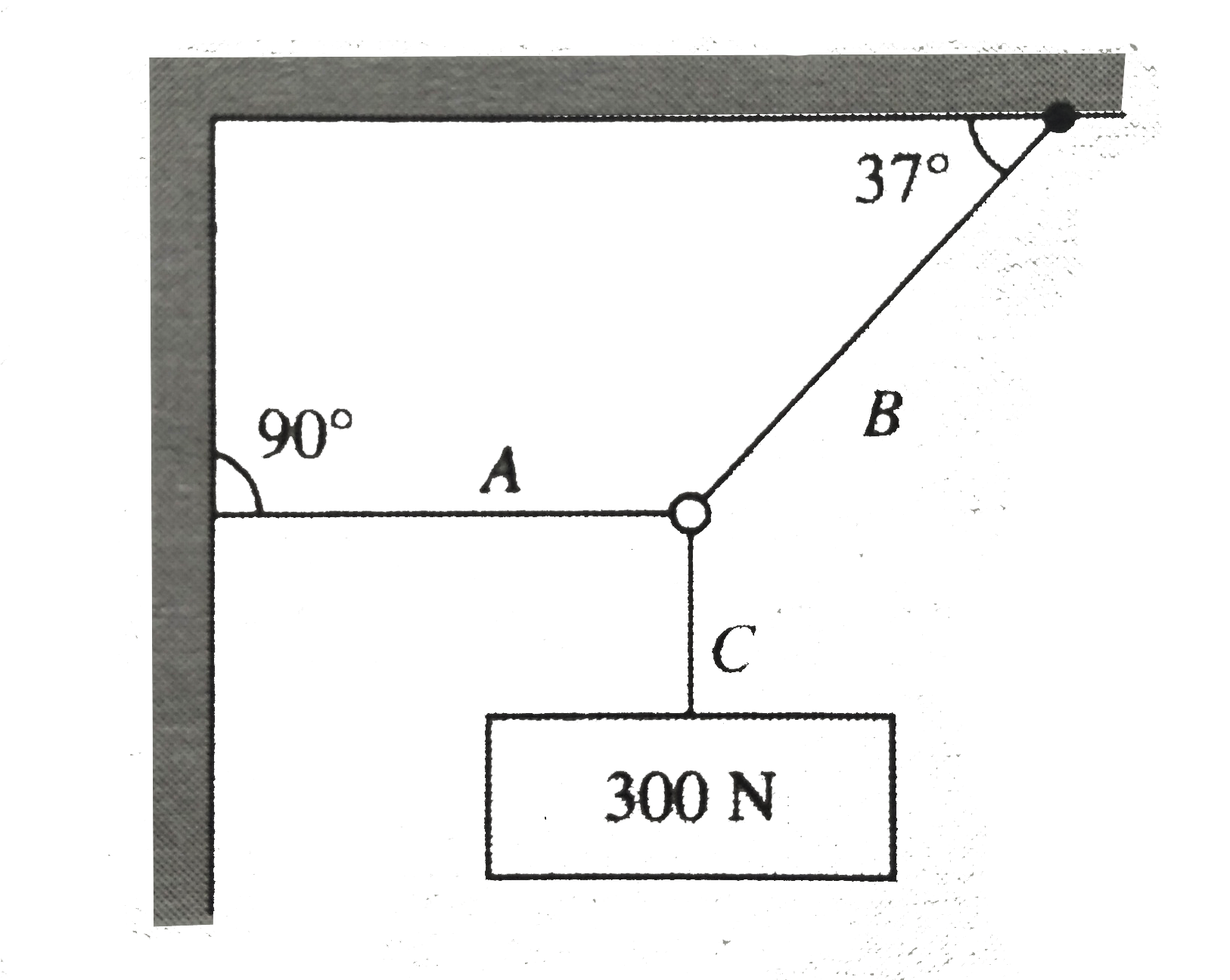A body of mass 50 kg, suspended by two strings of lengths 30 cm and 40 cm fastend to two points in the same horizontal line 50 cm apart, is in equilibrium. Find the tension (in Newtons) in each string.
To solve the problem of finding the tension in each string supporting a body of mass 50 kg, we will follow these steps:
Step 1: Understanding the Setup
We have a body of mass m=50kg suspended by two strings of lengths L1=30cm and L2=40cm. The horizontal distance between the points where the strings are attached is d=50cm.
Step 2: Convert Units
Convert the lengths from centimeters to meters for easier calculations:
- L1=0.3m
- L2=0.4m
- d=0.5m
Step 3: Calculate the Weight of the Body
The weight W of the body can be calculated using the formula:
W=m⋅g
where g≈10m/s2 (acceleration due to gravity). Thus,
W=50kg⋅10m/s2=500N
Step 4: Set Up the Geometry
Using the Pythagorean theorem, we can determine the angles at which the strings are inclined. The triangle formed by the lengths of the strings and the horizontal distance can be analyzed.
Step 5: Define Angles
Let:
- α be the angle for the string of length L1 (30 cm).
- β be the angle for the string of length L2 (40 cm).
Using the right triangle properties:
- cosα=d/2L1=0.250.3
- cosβ=d/2L2=0.250.4
Step 6: Resolve Tensions
Let T1 be the tension in the string of length 30 cm and T2 be the tension in the string of length 40 cm. We can resolve these tensions into their vertical and horizontal components.
In the horizontal direction:
T1cosβ=T2cosα
In the vertical direction:
T1sinβ+T2sinα=W
Step 7: Substitute Values
From the previous calculations, we can find:
- cosα=4050=45
- cosβ=3050=35
Substituting these into the horizontal equilibrium equation:
T1⋅35=T2⋅45
This simplifies to:
T2=34T1
Step 8: Substitute into Vertical Equation
Substituting T2 into the vertical equilibrium equation:
T1⋅45+(34T1)⋅35=500
This simplifies to:
T1⋅45+T1⋅920=500
Step 9: Solve for T1
Finding a common denominator (20):
T1(1620+920)=500
T1⋅2520=500
T1=500⋅2025=400N
Step 10: Find T2
Using T2=34T1:
T2=34⋅400=300N
Final Answer
The tensions in the strings are:
- T1=400N
- T2=300N
We have a body of mass m=50kg suspended by two strings of lengths L1=30cm and L2=40cm. The horizontal distance between the points where the strings are attached is d=50cm.
Convert the lengths from centimeters to meters for easier calculations:
- L1=0.3m
- L2=0.4m
- d=0.5m
The weight W of the body can be calculated using the formula:
W=m⋅g
where g≈10m/s2 (acceleration due to gravity). Thus,
W=50kg⋅10m/s2=500N
Using the Pythagorean theorem, we can determine the angles at which the strings are inclined. The triangle formed by the lengths of the strings and the horizontal distance can be analyzed.
Let:
- α be the angle for the string of length L1 (30 cm).
- β be the angle for the string of length L2 (40 cm).
- cosα=d/2L1=0.250.3
- cosβ=d/2L2=0.250.4
Let T1 be the tension in the string of length 30 cm and T2 be the tension in the string of length 40 cm. We can resolve these tensions into their vertical and horizontal components.
T1cosβ=T2cosα
T1sinβ+T2sinα=W
From the previous calculations, we can find:
- cosα=4050=45
- cosβ=3050=35
T1⋅35=T2⋅45
This simplifies to:
T2=34T1
Substituting T2 into the vertical equilibrium equation:
T1⋅45+(34T1)⋅35=500
This simplifies to:
T1⋅45+T1⋅920=500
Finding a common denominator (20):
T1(1620+920)=500
T1⋅2520=500
T1=500⋅2025=400N
Using T2=34T1:
T2=34⋅400=300N
The tensions in the strings are:
- T1=400N
- T2=300N
Topper's Solved these Questions
Similar Questions
A body of mass m is suspended by two strings making angles αandβ with the horizontal. Find the tensions in the strings.
View SolutionA body of mass 10 kg is suspended by a string and is pulled a side with a horizontal force of 49 N. Find the tension in the string, if the body is in equilibrium under these forces.
View SolutionA block of mass 30 kg is suspended by three string as shown in fig, Find the tension in each string.

View SolutionTwo identical small bodies each of mass m and charge q are suspended from two strings each of length l from a fixed point. This whole system is taken into an orbiting artificial satellite, then find the tensio in strings
View SolutionTwo light strings of length 4 cm and 3 cm are tied to a bob of weight 500 gm. The free ends of the strings are tied to pegs in the same horizontal line and separated by 5 cm. The ratio of tension in the longer string to that in the shorter string is
View SolutionTwo identical pith balls are charged by rubbing against each other. They are suspended from a horizontal rod through two strings of length 20 cm each, the separation between the suspension points being 5 cm. in equilibrium, the separation between the balls in 3 cm. Find the mass of each ball and the tension in the strings. the charge on each ball of a magnitude 2.0×10−8C.
View SolutionA particle of mass 200g is attached to an ideal string of length 1.30 m whose upper end is fixed to ceiling. The particle is made to revolve in a horizontal circle of radius 50 cm. The tension in the string is (g=10ms2)
View SolutionA block of mass 0.2 kg is suspended from the ceiling by a light string. A second block of mass 0.3 kg is suspended from the first block through another string. Find the tensions in the two strings. Take g=10ms2.
View SolutionTwo small spheres, each having a mass of 20 g, are suspended form a common point by two insulating strings of length 40 cm each. The spheres are identically charged and the speration between the balls at equilibrium is found to be 4 cm . Find the charge on each sphere.
View SolutionA mass of 2kg suspended by string of mass 6kg. A wave of wavelength 6 cm is produced at bottom of string. Wavelength of wave at top end of string will be
View Solution
